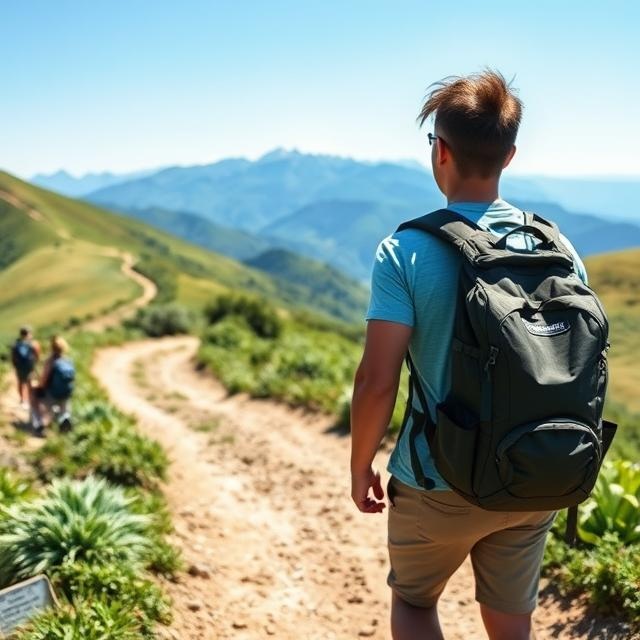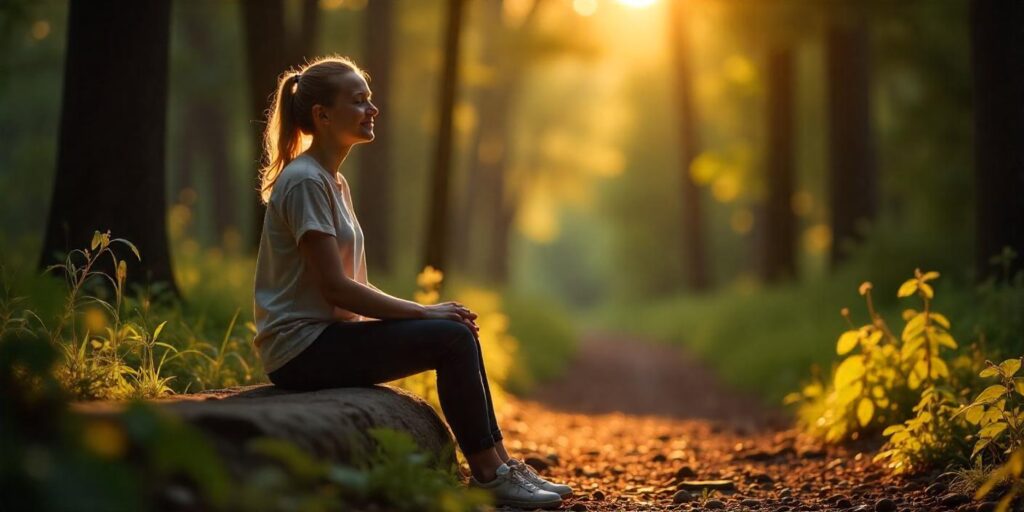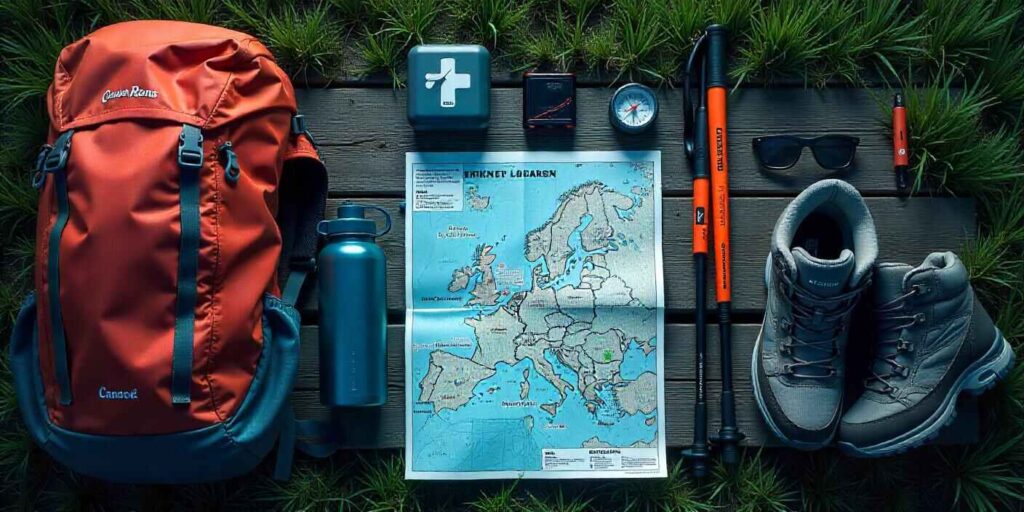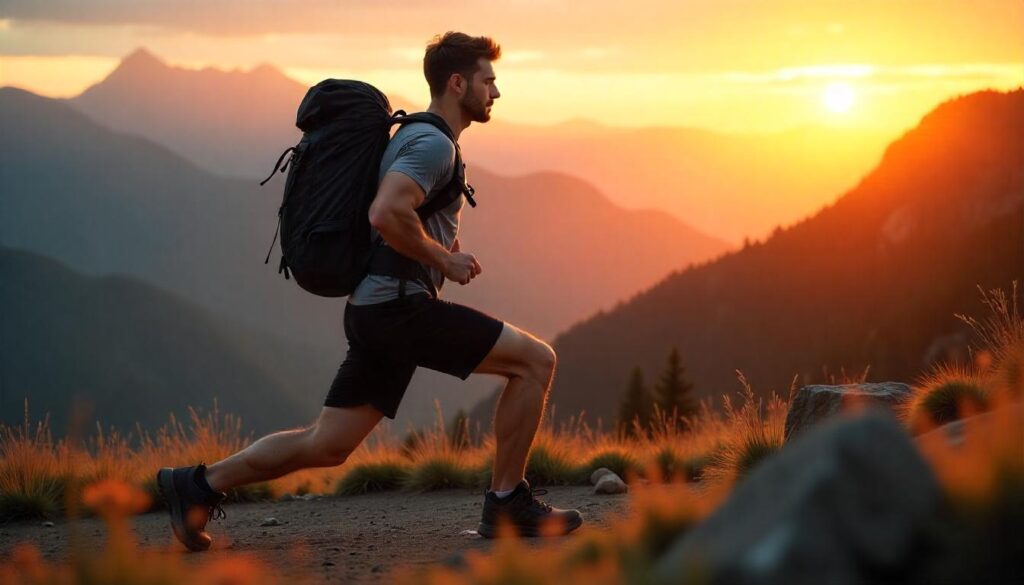
I still remember my first hike—excited yet completely unprepared.”
I had no clue what to pack, wore the wrong shoes, and underestimated how quickly I would get tired. I had no idea what to expect, and honestly, I wasn’t fully prepared. But despite the blisters and exhaustion, I fell in love with hiking. There’s something magical about stepping away from screens, breathing in fresh air, and feeling the crunch of dirt under your boots.
If you’re new to hiking, you might be feeling the same way—excited but unsure where to start. This guide on hiking for beginners will help you avoid the mistakes I made and get started away. The good news is that hiking is one of the best outdoor activities for beginners. It doesn’t require expensive gear, and you can start with easy trails that match your fitness level. Plus, hiking is only stressful if you’re unprepared, and that’s exactly what this beginners hiking guide will help you with.
By the end of this guide, you’ll have a clear understanding of how to start hiking, what gear to bring, how to stay safe, and how to make the most of your experience. Whether you’re looking for a fun weekend activity or hoping to make hiking a regular part of your lifestyle, this step-by-step guide will set you up for success.
Why Hiking is Great for Beginners?

Hiking is one of the most accessible and rewarding outdoor activities, making it a perfect choice for beginners. Here’s why:
1. Hiking is Great for Your Physical and Mental Health
As someone who has hiked dozens of trails, I can confidently say hiking improves both mental and physical health. Hiking improves cardiovascular health, strengthens muscles, and boosts endurance—all while allowing you to enjoy breathtaking natural landscapes. Unlike running or going to the gym, hiking engages your whole body in a low-impact way, making it easier on the joints.
But the benefits aren’t just physical. Hiking is also one of the best activities for mental well-being. A study conducted by Stanford University found that walking in nature reduces the risk of depression. The fresh air, greenery, and sense of adventure provide a natural escape from the pressures of daily life.
2. Hiking is More Affordable Than Other Outdoor Activities
Unlike cycling, skiing, or rock climbing, hiking requires very little upfront investment. You don’t need expensive equipment or lessons—just a comfortable pair of hiking shoes, appropriate clothing, and a backpack with essentials. Many trails are completely free to access, making it one of the most budget-friendly outdoor adventures.
3. Hiking is Easy to Start—No Experience Required
Some outdoor sports have a steep learning curve, but hiking is as simple as putting one foot in front of the other. If you can walk, you can hike! The key is to start small and gradually increase your difficulty level as you gain experience. Beginners can choose well-marked trails with gentle inclines and work up to more challenging hikes over time.
Essential Hiking Gear for Beginners

Hiking is one of the most rewarding outdoor activities, but having the right gear can make the difference between an enjoyable adventure and a stressful experience. Beginners often struggle with knowing what to pack, how much to carry, and which gear is truly essential. This guide will break down all the necessary hiking equipment so that you can hit the trails confidently and comfortably.
Hiking Gear Checklist
Before heading out on your first hike, you need to ensure that you have the right gear. Carrying too much can weigh you down, while bringing too little can leave you unprepared for unexpected situations. Here’s a detailed breakdown of the must-have and optional items for beginner hikers.
Must-Have Items
- Backpack – A well-fitted, comfortable backpack is essential for carrying all your hiking gear. Beginners should opt for a daypack (between 15-30 liters) for short hikes, while longer hikes may require a larger pack. Look for one with padded shoulder straps, a hip belt, and multiple compartments for better weight distribution.
- Navigation Tools – Even if you’re hiking on a marked trail, having a map, compass, and GPS device is crucial for staying on track. Many beginner hikers rely on their smartphones, but battery life can be unpredictable. Consider downloading offline maps on apps like Gaia GPS and carrying a physical map as a backup.
- Hydration System – Staying hydrated is vital for a successful hike. Bring at least 2 liters of water, depending on the weather and hike duration. Hydration bladders (like CamelBak) allow for hands-free drinking, while lightweight water bottles work well for shorter hikes. If your hike lasts several hours, a water filtration system or purification tablets can help you safely refill from natural water sources.
- Food and Snacks – Pack enough food to sustain your energy levels. High-protein, high-carb snacks like trail mix, granola bars, dried fruits, and nuts are excellent options. If you’re hiking for an entire day, lightweight meals such as peanut butter sandwiches, energy bars, or dehydrated meals are great choices.
- Proper Footwear – Your choice of footwear can make or break your hiking experience. Hiking shoes or boots with good traction, ankle support, and comfort are essential to prevent blisters and foot fatigue.
- Weather-Appropriate Clothing – The right clothing protects you from the elements and keeps you comfortable. Moisture-wicking base layers, insulating mid-layers, and a waterproof outer layer help you stay dry and warm in unpredictable weather conditions.
- Emergency Gear – Always carry a whistle, flashlight, multi-tool, and a small first-aid kit. Even for a short hike, injuries and unexpected situations can arise, so being prepared is essential.
Optional Items
- Trekking Poles – While not essential, trekking poles help reduce strain on your knees, improve stability on uneven terrain, and make steep descents easier. They are especially useful for beginners who are not yet used to the physical demands of hiking.
- Bug Spray and Sunscreen – Protection against the sun and insects is essential for comfort. A high-SPF sunscreen prevents sunburn, while an insect repellent helps keep mosquitoes and ticks at bay.
- Sitting Pad or Lightweight Camp Chair – If you plan on taking extended breaks, a compact sitting pad or foldable camp chair adds extra comfort when resting on rocky or damp terrain.
- Camera or Binoculars – If you enjoy photography or birdwatching, a lightweight camera or binoculars can enhance your hiking experience and help capture scenic views.
Best Hiking Footwear for Beginners

Choosing the right hiking shoes is one of the most important decisions for a beginner hiker. The wrong pair can lead to discomfort, blisters, and even injuries. On my first hike, I made the mistake of wearing regular sneakers. By the time I reached rocky terrain, I was slipping everywhere. That’s why a good grip is non-negotiable for beginners.
What to Look for in Hiking Shoes
- Fit and Comfort – Always try hiking shoes with the socks you plan to wear on your hike. There should be about a thumb’s width of space in the toe box to prevent toe bruising on downhill sections.
- Traction and Grip – The soles should provide excellent grip on various terrains, including rocky, muddy, or slippery trails. Look for shoes with Vibram soles or deep lug patterns for superior traction.
- Waterproofing – If you’re hiking in wet or rainy conditions, waterproof shoes will help in keep your feet dry. However, they may not be as breathable as non-waterproof shoes.
What to Wear While Hiking?
Wearing the right clothes makes a huge difference in comfort and safety.
Layering for Different Weather Conditions
- Base Layer – This layer wicks sweat away from your body. Choose moisture-wicking materials like merino wool or synthetic fabric (avoid cotton).
- Mid-Layer – This layer provides insulation and retains body heat. A fleece or lightweight down jacket is a great choice.
- Outer Layer – A waterproof and windproof jacket protects you from rain, snow, and strong winds.
Breathable Clothing and Moisture-Wicking Materials
Avoid wearing cotton, as it absorbs sweat and takes a long time to dry, leading to discomfort and possible hypothermia in cold conditions. Instead, choose polyester, merino wool, or nylon for quick-drying and breathable performance.
The Ten Essentials Every Hiker Must Carry
- Navigation Tools – Map, compass, and GPS device to prevent getting lost.
- Sun Protection – Sunglasses, sunscreen, and a hat to shield against UV rays.
- First Aid Kit – Basic supplies like bandages, antiseptic wipes, and pain relievers.
- Headlamp or Flashlight – Essential for early morning or late evening hikes.
- Multi-tool or Knife – Useful for emergencies, gear repairs, and food prep.
- Fire Starter – Matches, lighter, or fire starter to help with warmth and emergency signaling.
- Emergency Shelter – Lightweight bivvy sack or emergency blanket for unexpected situations.
- Extra Food – High-calorie snacks for energy in case of delays.
- Extra Water – Hydration system and purification tablets for clean water access.
- Extra Clothes – Layers for warmth and protection against changing weather conditions.
How Much Weight Should You Carry?
Carrying the right amount of weight is crucial for an enjoyable and safe hiking experience. Beginners should focus on carrying only essential items while keeping their backpack as light as possible.
What is the Weight Limit for Hiking? (Backpack Weight Formula Based on Body Weight)
A good rule of thumb for backpack weight is that it should not exceed 20% of your body weight for multi-day hikes and 10% for short day hikes. For example, if you weigh 150 pounds, your pack should be no heavier than 15 pounds for a day hike and 30 pounds for longer treks.
Ultralight Packing Tips for Beginners
Ultralight hiking is all about minimizing weight without sacrificing essential gear. Here are a few strategies to help beginners pack smarter:
- Use a lightweight backpack: Choose a frameless or minimalist backpack to cut down on unnecessary weight.
- Eliminate redundant items: Bring multi-purpose gear, such as a buff that can serve as a hat, neck warmer, and sweatband.
- Downsize food and water: Pack lightweight, high-calorie snacks and use a water filter instead of carrying excessive water.
- Opt for compact clothing: Avoid bulky cotton and bring lightweight, moisture-wicking clothes that can be layered.
- Cut down on unnecessary gadgets: A smartphone with offline maps can replace a separate GPS device, flashlight, and camera.
Choosing Your First Hiking Trail
Selecting the right hiking trail is a crucial step for beginners. The ideal trail should match your fitness level, offer scenic views, and provide a comfortable introduction to the world of hiking. Starting with an overly challenging trail can lead to frustration, exhaustion, or even injury. Instead, choose a trail that gradually builds your endurance and confidence. When selecting a trail, consider factors like distance, elevation gain, terrain difficulty, weather conditions, and accessibility. Here is what to look for in a beginner trail:
Trail Distance, Elevation, and Terrain Difficulty
Beginners should start with a short trail, typically between 1 to 3 miles round trip, with minimal elevation gain. Elevation gain refers to the total vertical distance you’ll climb, and for beginners, staying under 500 feet of elevation gain is ideal. Trails with steep inclines, rocky paths, or loose gravel can be challenging, so opting for well-maintained, marked trails is best. Smooth dirt paths or boardwalk trails are great for first-time hikers because they reduce the risk of slipping or tripping.
Consider Fitness Level, Elevation Gain, and Distance
Your current fitness level plays a big role in determining the best trail for you. If you’re just starting out, aim for flat or gently sloping trails that take no more than 1-2 hours to complete. More experienced beginners may try moderate trails with some uphill sections and slightly longer distances (3-5 miles). Checking the trail difficulty rating on apps like Hiking Project can help you gauge whether a trail is beginner-friendly.
Best Beginner Hiking Trails in the USA (Regional List)
There are plenty of beginner-friendly hiking trails across the United States, each offering scenic beauty and manageable terrain. Here are some excellent options:
- East Coast:
- Great Falls Park (Virginia) – A 3-mile scenic loop with stunning waterfall views.
- Mount Major (New Hampshire) – A 3.7-mile hike with moderate elevation and rewarding lake views.
- West Coast:
- Runyon Canyon (California) – A 2.7-mile loop with panoramic views of Los Angeles.
- Multnomah Falls Trail (Oregon) – A 2.6-mile hike leading to one of the most famous waterfalls in the U.S.
- Midwest:
- Turkey Run State Park Trails (Indiana) – Easy trails with unique sandstone formations.
- Starved Rock State Park (Illinois) – Several short trails leading to scenic waterfalls and canyons.
What is the Perfect Time & Weather for Hiking?
The best time to hike largely depends on the season and the region. Generally, spring and fall are the most comfortable seasons for hiking. Summer hikes can be enjoyable, but early morning or late afternoon hikes are best to avoid the heat. In winter, hiking is possible but requires extra preparation, such as proper insulation and traction gear. Checking the weather forecast before heading out is crucial to avoid rain, thunderstorms, or extreme temperatures.
Preparing for Your First Hike

Preparation is key to having a smooth and enjoyable hiking experience. Many beginners underestimate how much planning goes into a hike, which can lead to unexpected challenges. Proper preparation involves understanding basic safety measures, fitness training, and learning essential hiking skills. Taking the time to prepare ensures that your first hike is enjoyable, safe, and stress-free.
Hiking Safety Basics
Inform Someone About Your Trip
Before heading out on a hike, always let someone know where you’re going and when you expect to return. This step is essential, especially for solo hikers. If anything unexpected happens—such as getting lost or injured—having someone aware of your whereabouts increases the chances of getting help quickly. If you’re hiking in a remote area with no cell service, consider carrying a personal locator beacon (PLB) or a satellite communication device for emergencies.
Carry a Map, Compass, and First-Aid Kit
Even on well-marked trails, it’s essential to bring a physical map and a compass. While GPS apps on smartphones are useful, batteries can die, and signals can be lost. A first-aid kit is also a must-have. It should include bandages, antiseptic wipes, pain relievers, blister pads, and emergency supplies to handle minor injuries or discomforts along the way.
How to Train for Your First Hike
Building Endurance and Strength
Hiking requires both cardiovascular endurance and muscular strength. Beginners should start with regular walking sessions and gradually increase the distance and elevation. To improve leg strength, include exercises like squats, lunges, and calf raises in your routine. Hiking-specific workouts, such as using a treadmill at an incline, help prepare your body for uphill sections.
Hiking-Specific Exercises
To make hiking easier and prevent fatigue, incorporate the following exercises into your training plan:
- Step-ups: Simulate stepping up onto rocks and uneven surfaces.
- Planks: Strengthen your core for better balance on rough terrain.
- Resistance Band Workouts: Improve knee and ankle stability to prevent injuries.
What Are the Three Key Skills in Hiking?
Hiking isn’t just about walking in nature—it requires navigation, pacing, and trail awareness to ensure a safe and enjoyable experience. These three skills will help beginners hike efficiently while avoiding common mistakes.
Navigation – Using a Map, Compass, and GPS Apps
Navigation is the most critical skill in hiking. While many beginner-friendly trails are well-marked, getting lost is still possible. Learning how to read a topographic map, use a compass, and understand GPS coordinates can prevent disorientation. Always carry a paper map as a backup.
Pacing & Endurance – Maintaining Energy, Avoiding Burnout
New hikers often start too fast and tire out quickly. Maintaining a steady, comfortable pace is key to conserving energy. A good rule is to hike at a pace where you can hold a conversation without gasping for breath. Taking regular breaks (every 30–45 minutes) to drink water, eat snacks, and stretch helps maintain endurance throughout the hike. But avoid stopping for too long to prevent muscle stiffness.
Trail Awareness – Reading Terrain, Avoiding Common Mistakes
Being aware of your surroundings is important for both safety and navigation. Pay attention to trail markers, signs, and landmarks so you don’t accidentally take the wrong path. Be mindful of slippery areas, loose rocks, and wildlife that may require extra caution. One common beginner mistake is ignoring weather changes—always be prepared for sudden shifts in temperature, rain, or wind by checking the forecast and packing appropriately.
Top Hiking Tips for Beginners
Starting your hiking journey can be overwhelming, but with the right approach, it becomes an enjoyable and rewarding experience. Many beginners struggle with pacing, hydration, and avoiding common mistakes, which can make their hike more difficult. These tips will help you conserve energy, stay safe, and fully enjoy your adventure.
Pacing & Endurance – Maintaining Energy, Avoiding Burnout
New hikers often start too fast and tire out quickly. Maintaining a steady, comfortable pace is key to conserving energy. A good rule is to hike at a pace where you can hold a conversation without gasping for breath. Taking regular breaks (every 30–45 minutes) to drink water, eat snacks, and stretch helps maintain endurance throughout the hike. But avoid stopping for too long to prevent muscle stiffness.
Staying Hydrated & Energy Management
Dehydration and low energy levels can make hiking exhausting. Drink water every 15–20 minutes, even if you don’t feel thirsty, to maintain hydration. On longer hikes, electrolyte drinks or salty snacks help replenish lost minerals and prevent muscle cramps. Pack high-energy snacks like nuts, trail mix, and protein bars to keep your body fueled. Eating a balanced meal before hiking (rich in carbs, protein, and healthy fats) ensures you have long-lasting energy. Avoid caffeine and alcohol before hiking, as they can cause dehydration and fatigue.
Budget-Friendly Hiking Tips
Hiking doesn’t have to be expensive. With some smart choices, you can gear up without breaking the bank. Many affordable alternatives exist for quality hiking equipment, and you can find ways to hike without spending a lot of money.
Affordable Gear Alternatives
Look for second-hand hiking gear from online marketplaces or outdoor stores that sell used equipment at discounted prices. Renting gear from local outdoor shops is a great way to test equipment before investing in expensive purchases. Moisture-wicking gym clothes work just as well as branded hiking apparel, so avoid unnecessary spending. Prioritize sturdy footwear and a comfortable backpack, as these two items have the biggest impact on your comfort.
Trail Etiquette & Leave No Trace

Hiking is not just about enjoying nature—it’s also about respecting the environment and other hikers. Following proper trail etiquette and Leave No Trace principles helps preserve trails and ensures a better experience for everyone.
Hiking Etiquette
Proper trail manners make hiking safer and more enjoyable for all. Yield to uphill hikers if you’re going downhill, and step aside for faster hikers to pass. On shared trails, bikers yield to hikers, and hikers yield to horses. Keep noise levels low to respect wildlife and fellow hikers. If hiking in a group, walk in a single file to avoid blocking the trail. Always be friendly—a simple greeting goes a long way in creating a positive hiking environment.
Leave No Trace Principles
Leaving nature as you found it ensures that trails remain beautiful and accessible for future hikers. Always pack out all trash, including food wrappers and biodegradable waste like fruit peels. Stay on designated trails to avoid damaging vegetation and wildlife habitats. If you need to relieve yourself outdoors, follow proper waste disposal guidelines by digging a small hole away from water sources. Avoid disturbing wildlife by keeping a safe distance and never feeding animals. By following these principles, you help protect nature and maintain pristine hiking environments.
Conclusion & Call to Action
Hiking is one of the most accessible and rewarding outdoor activities for beginners. With the right preparation, gear, and knowledge, anyone can enjoy the beauty of nature while improving their physical and mental well-being. In this guide, we covered essential hiking tips, from choosing the right trail to staying safe and comfortable on your journey.
If you’re just starting, remember to pace yourself, stay hydrated, and follow trail etiquette to ensure a smooth experience. Investing in the right footwear and essential gear can make your hike more enjoyable without overspending. Most importantly, always respect nature and Leave No Trace to preserve the environment for future adventurers.
We’d love to hear about your first hiking experience! Share your thoughts, challenges, and favorite trails in the comments to help inspire and guide other beginners.
FAQs: Answering Common Beginner Questions
What Should I Do If I Get Lost?
If you get lost, stop moving immediately and stay calm. Look for trail markers, landmarks, or footprints to retrace your steps. Use a map, compass, or GPS app to reorient yourself. If you have cell service, check a hiking app for your location. If you’re completely lost, stay put and signal for help using a whistle (three blasts), bright clothing, or a signal mirror. Always let someone know your hiking plans before heading out.
How Can I Prevent Blisters While Hiking?
Wear well-fitted, broken-in hiking shoes and moisture-wicking socks (merino wool or synthetic blends) to reduce friction. Avoid cotton, as it retains moisture. Apply anti-chafing balm, foot powder, or moleskin on high-friction areas like heels and toes. If you feel a hot spot forming, stop immediately, adjust your socks or shoes, and cover the area to prevent a blister from developing.
Ethan Marlowe is an experienced hiker and outdoor gear specialist based in Colorado. With over 7 years of hands-on experience trekking through the Rockies, Pacific Northwest, and East Coast trails, he delivers practical advice, expert gear reviews, and survival insights. His goal is to help hikers of all levels make smarter decisions on and off the trail.


